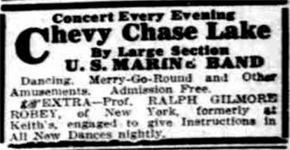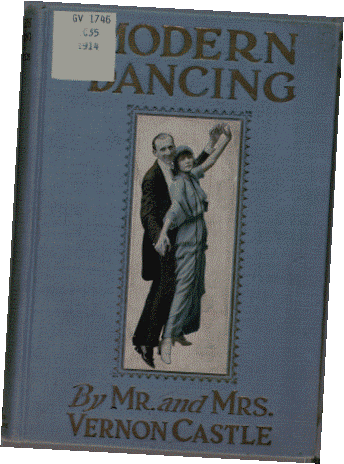Dancing Lessons at Chevy Chase Lake
Irene and Vernon Castle demonstrated their interpretations of the "new" dances in theaters on Broadway as well as at exclusive night clubs abroad, and as their fame grew, they opened a dancing school called "Castle House," in Long Beach, New York. They were young, talented, beautiful, and very important -- they were married. Their marital status helped them assure their audiences that their forms of dancing were not overtly sexual or dangerous. In addition to public appearances, the Castles published dancing instructions in newspapers and appeared in popular movies. They taught their audiences how to do the new dances and still maintain their dignity, making the formerly “freak” dances respectable, especially the fox trot.

Although there were dance demonstrations and exhibitions at Chevy Chase Lake, we have found no evidence that the Castles performed there. But there was a tradition of dancing lessons and demonstrations at the amusement park.
For example, in 1909, preceding the dance craze, Miss Coulter gave private dances at Chevy Chase Lake. Admission was 25 cents, according to a small notice in The Washington Post on May 9th.
And in 1914, still during the era of the Marine Band but definitely during the “dance craze,” an article in The Washington Times on July 19th, p. 12, discusses the popularity of dance demonstrations by Professor Robey and his partner Miss Fairfax:
Interest in the appearance of the professional dance demonstrators at Chevy Chase Lake gives no evidence of waning. The big pavilion is thronged every evening to witness the artistic dancing of Prof. Robey and his partner, Miss Fairfax. They vary their exhibitions from night to night, one evening giving the hesitation and tango, the next demonstrating the one-step and the maxixe [a Brazilian form of the tango].

The Washington Times, May 31, 1914, p. 13. 
p. 99 from Albert W. Newman, Dances of To-Day. Philadelphia: The Penn Publishing Company, 1914. From the Library of Congress "An American Ballroom Companion: Dance Instruction Manuals." LOC GV1755 .N5.
In the advertisement above, Prof. Ralph Gilmore Robey is listed as an "extra" who was formerly at Keith's, the vaudeville theater in downtown Washington. At the end of the summer, The Washington Times ran an announcement about Chevy Chase Lake on September 6, 1914, p. 14, noting that Mr. Robey and his dance partner would demonstrate two new dances: the foxtrot and a combination step danced to alternating one-step and waltz time. Finally, they planned to demonstrate a dance called the “Lu Lu Fado, the very newest terpsichorean novelty.”
In the same issue of the Washington Times, September 6, 1914, another notice ran on p. 12 announcing that after a successful summer demonstrating dances at Chevy Chase Lake, Mr. Robey planned to open a dance studio at Fourteenth and U Streets. He planned to go to New York to see all the newest dances before opening his studio. His partner, Miss Mabel Fairfax, also opened a dance studio after their successful summer season at Chevy Chase Lake. On November 12, that same year,The Washington Post ran a small advertisement on p. 14 announcing the opening of her dance studio at 1210 G St. NW.
The Influence of Irene and Vernon Castle

Although Irene and Vernon Castle may not have actually demonstrated their dancing at Chevy Chase Lake, they played an important role in popularizing and “interpreting” the new dances, making them acceptable at a “high class park” like Chevy Chase Lake. And they helped dancers like Mr. Robey and Miss Fairfax advance their careers as instructors.
As the Castles wrote in the Forward to their 1914 book, Modern Dancing:
"Our aim is to uplift dancing, purify it, and place it before the public in its proper light. When this has been done, we feel convinced that no objection can possibly be urged against it on the grounds of impropriety..."
Irene and Vernon Castle


